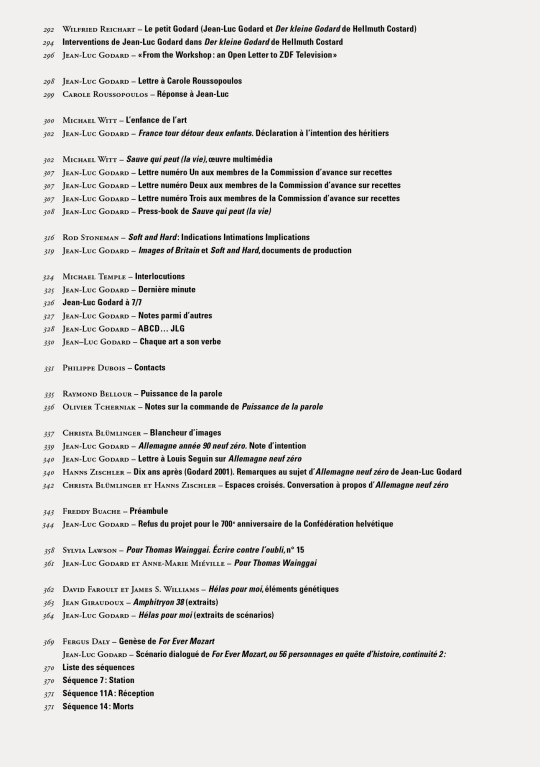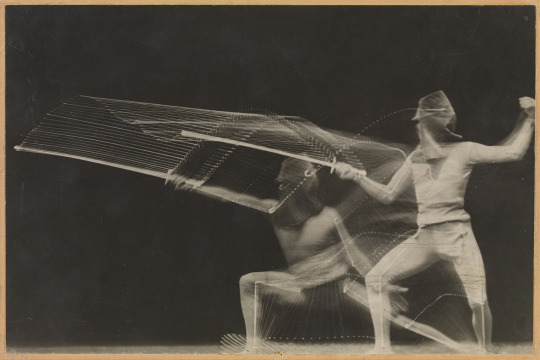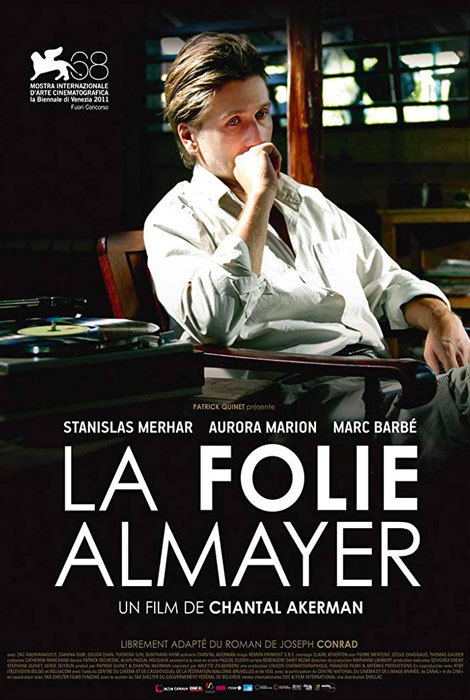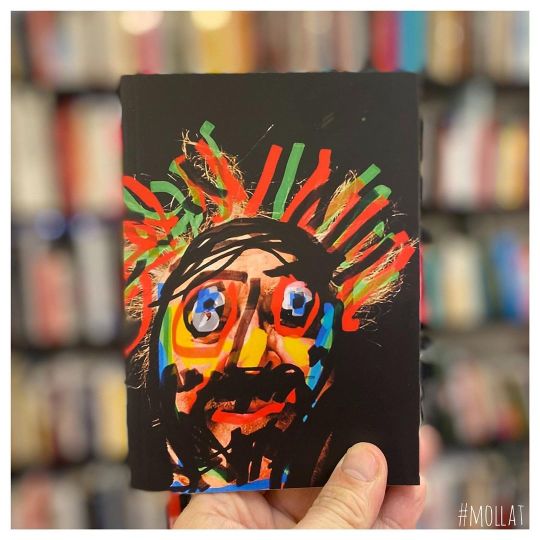#Nicole Brenez
Text

Jean-Luc Godard: Documents, Edited by Nicole Brenez, David Faroult, Michael Temple, James Williams, and Michael Witt, Éditions du Centre Pompidou, Paris, 2006 (pdf here) [ESACM – École supérieure d'art de Clermont Métropole, Clermont-Ferrand]






Exhibition: Voyage(s) en utopie, Jean-Luc Godard, 1946-2006, Galerie Sud, Centre Pompidou, Paris, May 11 - August 14, 2006
Cinema: Jean-Luc Godard. A Complete Retrospective: 140 films, Documents: 75 films, Cinéma 1 / Cinéma 2, Centre Pompidou, Paris, April 24 – August 14, 2006
#graphic design#art#film#notation#visual writing#exhibition#catalogue#catalog#cover#jean luc godard#nicole brenez#david faroult#michael temple#james williams#michael witt#centre pompidou#editions du centre pompidou#2000s
27 notes
·
View notes
Text

5 notes
·
View notes
Text
Almayer's Folly (2011)
Almayer's Folly by #ChantalAkerman, "If only the film was as commanding as it is stunning in its pictorial magnificence",
CHANTAL AKERMAN
Bil’s rating (out of 5): BB.5
Original Title: La folie Almayer
Belgium/France, 2011. Centre du Cinéma et de l’Audiovisuel de la Fédération Wallonie-Bruxelles, Artemis Productions, Belgacom, Canal+, Centre National du Cinema et de L’Image Animee, Cine+, Liaison Cinématographique, Paradise Film, Radio Television Belge Francophone, Tax Shelter Film Funding, Tax Shelter du…

View On WordPress
#Alain-Pascal Housiaux#Artemis Productions#Aurora Marion#Belgacom#Belgium#Bunthang Khim#Canal+#Catherine Marchand#Centre du Cinéma et de l&039;Audiovisuel de la Fédération Wallonie-Bruxelles#Centre National du Cinema et de L&039;Image Animee#Chantal Akerman#Cine+#Claire Atherton#France#Henry Bean#Joseph Conrad#Liaison Cinématographique#Marc Barbé#Nicole Brenez#Paradise Film#Patrick Dechesne#Patrick Quinet#Radio Television Belge Francophone#Rémon Fromont#Sakhna Oum#Solida Chan#Stanislas Merhar#Tax Shelter du Gouvernement Fédéral Belge#Tax Shelter Film Funding#TIFF 2011
0 notes
Text
💉
[sobre Jorge Amaro/fritz]
Entrevista a Nicole Brenez (Artecapital, 2020)
https://www.artecapital.net/estado-da-arte-113
0 notes
Text
BANI KHOSHNOUDI

Jeudi 6 juin 2023 à 19h (heure de Paris)
Thursday June 6th 2023, 7pm (Paris time)
D’origine iranienne, Bani Khoshnoudi (née à Téhéran) immigre aux États-Unis à l'âge de deux ans, pendant la révolution iranienne de 1979. Elle fait des études d’architecture, de photographie et du cinéma à l’Université du Texas à Austin puis suit, en 2008, le Independent Study Program du Whitney Museum (New York). Son travail, marqué par le déracinement, et le déplacement, explore l’exil, la modernité et ses violences, la mémoire et l’invisible. Alors qu’elle creuse dans ses films, documentaires et fictions,—« Transit » (2005), « A People in the Shadows » (2008), « The Silent Majority Speaks » (2010-14), « Luciérnagas » (2018)—des couches d’histoire et des expériences en relation avec les migrations mondiales, les nomadismes et les luttes historiques pour la liberté, ses photographies et installations travaillent aussi les textures et les traces de ces histoires, l’architecture et les ruines, les empreintes humaines sur la terre.
Son film « The Silent Majority Speaks », interdit au Liban et considéré comme « offensant pour le régime iranien », a fait partie de l’exposition , “Soulèvements" (Georges Didi-Huberman/Jeu de Paume, Paris), et a été nommé par la programmatrice et critique française, Nicole Brenez, comme l'un des dix films essentiels du siècle. En 2014, elle a collaboré avec les cinéastes Harun Farocki et Antje Ehmann sur leur projet "Labor in a Single Shot" à Mexico. Le travail de Bani Khoshnoudi a été exposé dans de nombreuses institutions, notamment le Centre Georges Pompidou et la Fondation Cartier (Paris), l’ ICA Londres, la Haus der Kulturen der Welt (Berlin), le Musée Universitaire d’Art Contemporain et le Musée El Eco (Mexico), la Fundaçao Serralves (Porto), le Musée d’Art Contemporain (Zagreb). En 2009, elle s’est installée à Mexico City où elle continue à travailler aujourd’hui, ainsi qu’en France En 2022 elle a reçu le Herb Alpert Award in the Arts dans la catégorie Film/Vidéo.
[EN] Filmmaker and visual artist, Bani Khoshnoudi was born in Tehran and immigrated to the United States in 1979 during the revolution. She studied architecture, photography and cinema at the University of Texas at Austin, and then continued her studies at the Independent Study Program of the Whitney Museum in New York. Her works, inhabited by displacement and uprooting, explore themes of exile, modernity and its effects, memory and the invisible. While her documentary and fiction films – ‘Transité (2005), ‘A People in the Shadows’ (2008), ‘The Silent Majority Speaks’ (2010-14),’ Luciérnagas’ (2018)- dig into the layers, stories and experiences related to global migrations, nomadisms and historical struggles for freedom, her photographs and installations also work with the textures and traces of these stories; architecture and ruins, human imprints on the earth.
Her most well known film, the documentary essay ‘The Silent Majority Speaks’, was banned in Lebanon in 2014 and considered as “offensive to the Iranian regime”. This political fresco about 100 years of political revolt in Iran was included in Georges Didi-Huberman’s exhibition book, ‘Uprisings’ for the Jeu de Paume Museum in Paris, and was named by French curator and critic, Nicole Brenez, as one of ten essential films of the century. In 2014 she collaborated with filmmaker Harun Farocki and Antje Ehmann on their project “Labor in a Single Shot” in Mexico City. Bani’s work has been shown at the Centre Pompidou, ICA London, Fondation Serralves in Porto, Fondation Cartier, MUAC Museum of Contemporary Art and Museo El Eco in Mexico City, and the Museum of Contemporary Art Zaghreb, among others. In 2009, she moved to Mexico City and continues working there today while splitting her time between Mexico and France. In 2022, Bani was awarded the
Herb Alpert Award in the Arts
in Film/ Video.
Programmation et prochains rendez-vous sur ce site ou par abonnement à la newsletter : [email protected]
Pour regarder les séminaires antérieurs : http://www.vimeo.com/sysk/
Séminaire conçu et organisé par Patricia Falguières, Elisabeth Lebovici et Natasa Petresin-Bachelez et soutenu par la Fundación Almine y Bernard Ruiz-Picasso para el Arte
0 notes
Text
1 note
·
View note
Text



FRÈRES d'Ugo Simon
Chef opératrice, étalonneuse
Mahamadou, Diané et Farid ont chacun perdu un frère à la suite d’une intervention de la police française au cours des dix dernières années. Depuis, ils vivent au quotidien avec la souffrance, l’impossibilité de faire le deuil et la détermination à obtenir justice.
Documentaire - 43 min - La fémis - 2021
Brives 2022 - Lussas 2022
Autour du film : entretien pour Débordements - entretien pour Mediapart par Nicole Brenez - page Tënk du film
0 notes
Photo

💚♥️🖤💙💛 Jean-Luc Godard (écrits politiques sur le cinéma et autres arts filmiques tome 2) Nicole Brenez publié par de l’incidence éditeur #jeanlucgodard #cinema #cinemapolitique #librairie #mollat #bordeaux (à librairie mollat) https://www.instagram.com/p/CoXsXTgqMf-/?igshid=NGJjMDIxMWI=
0 notes
Photo

Stanislas Merhar in Almayer's Folly (Chantal Akerman, 2011)
Cast: Stanislas Merhar, Marc Barbé, Aurora Marion, Zac Andrianasolo, Sakhna Oum, Solida Chan. Screenplay: Chantal Akerman, Henry Bean, Nicole Brenez,
based on a novel by Joseph Conrad. Cinematography: Rémon Fromont. Production design: Patrick Dechesne. Film editing: Claire Atherton
Lots of movies -- think of Sunset Blvd. (Billy Wilder, 1950) and Inside Llewyn Davis (Joel Coen and Ethan Coen, 2014), for example -- begin with an incident and then flash back for the rest of the movie to explain it. So Chantal Akerman's Almayer's Folly begins with the camera following a Malaysian man into a nightclub where another man is lip-synching to Dean Martin's version of the song "Sway" as a group of women dances behind him. Suddenly the man who entered the club is on stage stabbing the lip-syncher. The music breaks off and all of the dancers flee the stage except one, who continues to perform the hula-like hand movements as if nothing had happened. We hear a voice call out, "Nina! Nina!" but she continues in her trance-like state for a while until she stops and begins to sing Mozart's setting of "Ave Verum Corpus" as the camera holds on her in closeup. The movie then flashes back to reveal that Nina (Aurora Marion) is the daughter of the European Almayer (Stanislas Merhar) and a Malaysian woman, Zahira (Sakhna Oum). Almayer has come to Malaysia in search of his fortune -- he has heard of a gold mine ripe for the taking. Zahira and Nina live with him in a house by the river until one day his fellow European fortune-hunter, Captain Lingard (Marc Barbé), arrives to take Nina to the city to be educated: Almayer wants her to have the benefits and privileges of a European lady. Though Zahira and Nina flee into the jungle, Almayer and Lingard capture the girl. Nina is intensely unhappy at the school, scorned by the European girls, and when Lingard, who has been paying her tuition for Almayer, dies, she is expelled. She wanders the streets of the unnamed Malaysian city (the movie was actually filmed in Cambodia) and finally returns to Almayer's home. There she's seduced by Daïn (Zac Andrianasolo), a shady young man who is supposedly helping Almayer find his fortune. Almayer recognizes his defeat and allows Nina and Daïn to leave together. Unlike Wilder and the Coens, Akerman doesn't return to the opening scene at the film's end, but instead leaves us with two of her characteristic long takes: The first shows Almayer, Nina, and Daïn arriving at a sandbar where the river meets the sea to await the arrival of the boat that will take the two young people away; the camera lingers in a long shot as the boat arrives and Nina and Daïn swim out to it, then Almayer and his servant, Chen (Solida Chan), push off into the river for their return home. The second long take is a closeup of the haggard, obviously very ill Almayer as he sits brooding in his decaying home, with Chen standing out of focus in the background. At the beginning of this take, Almayer says, "Tomorrow, I would have forgotten," a sentence that he repeats at the end after we watch the sun play across his face -- moving much more swiftly than it would in actuality -- and he talks about how the sun is cold and the river is black. By now, we have realized that the lip-syncher was Daïn and that Chen was his assassin. As for Almayer, we can only assume that he has died. Almayer's Folly, which Akerman loosely adapted from the early Joseph Conrad novel, is clearly a fable about the tragedy of colonialism, but she's not intent on laboring that topic. It's as much an attempt to prod the viewer into contemplating the mystery of character and identity as her more celebrated Jeanne Dielman, 23 Commerce Quay, 1080 Brussels (1975) was, and by using less radical variations on the same techniques -- extended takes, minimized action -- she used in that film. Akerman developed a compelling and identifiable style, but there is a point at which style becomes mannerism. (We all want to be thought "stylish," and none of us want to be thought "mannered.") I think Almayer's Folly nears that point but doesn't fully reach it, largely because of the compelling performance of Merhar as Almayer, and because of Akerman's use of the setting, with the help of Rémon Fromont's cinematography and Claire Atheron's editing. She also makes fine ironic use of the Dean Martin song and the Mozart hymn, as well as the only non-diegetic music in the film, interludes filled with the erotic longing of Wagner's Prelude to Tristan and Isolde.
0 notes
Text
paraphrasing Nicole Brenez
These are films that resist, that one must surmount just as Bergman scaled her volcano, and that change you forever; there are also appetizing films which allow you to unexpectedly uncover an entire world; there are the films that accompany you through your life; the film to which you instinctively compare all others; the film that runs through your head like a popular song and in which the familiar images keep coming back in the same way that you hum the refrain; those you can’t watch again because you’ve loved them too much; those that you understand in fragments, slowly, throughout a lifetime; those that you hope to understand one day; those for which you must wait to become much stronger; those that suddenly offer you everything you needed. But I never encountered a film that made me turn away from cinema.
from Dear Jonathan, dear Adrian, dear Kent, lieber Alex,
0 notes
Quote
While my tendency has always been towards Bresson, I think that it’s possible to go towards the same, essential materiality through the opposite path, through melodrama. Bresson and Sirk, two opposing paths that finally meet; the final shot of Pickpocket (1959) could be put at the end of a Douglas Sirk film.
chantal and some comrades. fragments. by nicole brenez (2011 interviews with chantal akerman)
15 notes
·
View notes
Text

Jean-Luc Godard, MANIFESTE, «El Fatah», July 1970; in Jean-Luc Godard: Documents, Edited by Nicole Brenez, David Faroult, Michael Temple, James Williams, and Michael Witt, Éditions du Centre Pompidou, Paris, 2006, pp. 138-143 (pdf here) (English translation here) [ESACM – École supérieure d'art de Clermont Métropole, Clermont-Ferrand. «Diagonal Thoughts»]





#graphic design#art#manuscript#notebook#magazine#notation#visual writing#exhibition#catalogue#catalog#jean luc godard#el fatah#nicole brenez#david faroult#michael temple#james williams#michael witt#centre pompidou#editions du centre pompidou#1970s#2000s
12 notes
·
View notes
Photo



Printtemps
Jacques Perconte / Nicole Brenez, 2020
2 notes
·
View notes
Quote
NICOLE BRENEZ: Pero entonces, frente a la catástrofe, ¿qué se puede hacer?
CHANTAL AKERMAN: Puedo señalar el camino, mostrar los lugares en los que los cuerpos están enterrados. Es mejor evocar, es más efectivo tanto para ti como para los espectadores. Al final esas imágenes literales [se refiere a las imágenes de cuerpos muertos] no conmueven; tienes que encontrar otro camino, de modo que las personas que se enfrentan a ello puedan seguir siendo ellos mismos y absorberlo en un cara a cara real con las imágenes. Por eso tiendo a filmar las cosas de manera frontal.
NB: Pero una cara vista de frente, contra una pared, es un esquema plástico del arte bizantino y no existe nada más sacralizador. Por culpa del primer plano, como decía Epstein, el cine es «teogónico».
CA: Pero es material y se mueve, incluso cuando parece fijarse. Y cuando evitas filmar con contrapicados y ángulos subjetivos, evitas el fetichismo. Cuando filmas frontalmente, colocas dos almas cara a cara, en una posición de igualdad, esculpes un lugar real para el espectador. Por lo tanto, no tiene nada de teogónico. Contemplas algo que está fijado. No hay párpado que pestañee ni corazón que bata.
NB: Por lo tanto, tu concepción de la imagen consiste en una batalla que se libra en dos frentes: por un lado contra la literalidad del acto; por el otro, contra la producción de imágenes idolátricas.
CA: Sí, normalmente lo literal conlleva que uno esté más cerrado. Aunque depende de a qué llamemos literal. Para los judíos, el orden ético tiene que ver con la relación con el Otro, algo que Levinas analizó muy bien. Estar frente a frente con el otro. Tu sentido de la responsabilidad comienza con esta confrontación cara a cara. Levinas diría: «Ahora que lo entiendes, no puedes asesinar». Esa es mi idea de la ética. Es por lo que siempre busco una igualdad entre la imagen y la persona que la observa.
Chantal Akerman, «Chantal Akerman: The Pajama Interview», disponible online en el sitio web de Lumière. Entrevistas realizadas por Nicole Brenez entre el 15 de julio y 6 de agosto de 2011.

3 notes
·
View notes
Photo

Uprisings
by Georges Didi-Huberman
709 D556u
#uprisings#georges didi-huberman#books#book#uarts#uarts libraries#uarts library#uartslibraries#jeu de paume#gallimard#Nicole Brenez#Judith Butler#Marie-Josè Mondzain#Antonio Negri#Jacques Rancière#dissident art#art exhibition#art exhibitions#art#paris#art book#exhibition catalogs
0 notes
Text
RAW Académie Session 7 (Dakar)
Deadline: 30 June 2019 + only the first 75 applications will be considered for review

RAW Académie is an experimental residential program for the research and study of artistic and curatorial practice and thought. The program takes place over 7 weeks in Dakar. It is dedicated to a dynamic reflection on artistic research, curatorial practice and critical writing.
Session 7: “Images for our times” will be led by the artist and filmmaker Eric Baudelaire (FR). It will take place from October 28 to December 13, 2019.
Images for our times will be structured around rituals and repetition. The program will not be production focused, but fellows will be encouraged to work on small projects, make images in Dakar, and share them with the fellows during dedicated weekly viewing sessions.
The curriculum will be shaped each week by the visiting faculty members: filmmakers and artists John Akomfrah, Mati Diop, Alain Gomis, Joana Hadjithomas and Khalil Joreige, Alfredo Jaar, Naeem Mohaiemen, curator and writer Rasha Salti, and film scholar Nicole Brenez.
Criteria
This session is open to filmmakers and artists interested in working with moving images, as well as film programmers, curators, researchers, and art historians with a commitment to the moving image.
Successful applicants are required to commit to being in Dakar throughout the duration of the session.
Applicants must be a graduate of an art school, curatorial programme, architecture school or any department of humanities.
Applicants must be fluent in either French or English and have a fair knowledge of the other. Successful applicants will be skype interviewed in both languages for assessment.
Benefits
The programme is tuition-free. Successful applicants will have to cover their travel arrangements (including visa), accommodation, insurance and costs of living in Dakar for 7 weeks. Depending on the work schedule, simple meals/snacks may be offered occasionally.
Details
Apply
Image: Eric Baudelaire, Also Known As Jihadi (still), 2017. Film.
3 notes
·
View notes